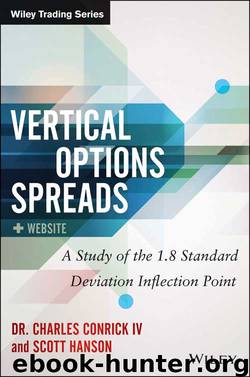Vertical Option Spreads + Website: A Study of the 1.8 Standard Deviation Inflection Point (Wiley Trading) by Conrick Charles & Hanson Scott

Author:Conrick, Charles & Hanson, Scott [Conrick, Charles]
Language: eng
Format: epub
ISBN: 9781118739693
Publisher: Wiley
Published: 2013-09-04T00:00:00+00:00
■ The CAPM
Here is CAPM 101 in a nutshell. Risk consists of both systematic (market or nondiversifiable) risk and unsystematic (diversifiable) risk. No investor can eliminate systematic risk as this risk is inherent in any and all market activity. If investors want no risk, they must invest all of their assets in the risk-free asset and earn paltry returns or if they do invest in the market, they must diversify their risk among a bundle of assets that perform differently (co-vary) under varying market conditions. A bundle of assets that performs differently means their performances have higher covariance, meaning they are not well correlated. Conversely, if investors put all their money into one asset, say Apple Computers, they live or die with just Apple's performance. In short, they assume all of Apple's unsystematic or diversifiable risk. Clearly, one is putting all his Apple(s) in one basket, which, from an investment perspective, is overly risky and therefore irrational. The investor would be far more prudent to invest in a well-diversified portfolio such as the market, which is well diversified and eliminates unsystematic (diversifiable) risk.
If the market, of which is a good surrogate of which is the S&P 500 index, as to annual returns and its standard deviation, and we have the aforesaid risk-free rate, the entire investment decision becomes a linear paradigm. Since 1926, the S&P 500 has earned an annual rate of return of about 10 percent with a standard deviation of about 20 percent, according to Ibbotson and Associates. High grade corporate bonds have earned an annual return of about 6.5 percent with a standard deviation of 9.2 percent. The S&P 500 Index (market) consists of hundreds of well diversified stocks, meaning that by owning the index, an investor owns a well-diversified portfolio.
This confluence of various assets—ranging from the risk-free rate up through bonds with higher return but more risk along with “the market,” a basket of equities with varying returns that have different risks or covariances, thus meaning they are not highly correlated—led to the seemingly simple but extremely elegant CAPM.
It could be argued that Markowitz's studies laid the foundation, while Sharpe, Lintner, and Mossin, along with Fama and French, built the house in the 1960s that led to the CAPM model, which remains the cornerstone of MPT to this day. As we have discussed, standard deviation measures total risk by observing all data points related to the mean. The CAPM's theoretical underpinning is that since unsystematic risk can be diversified away simply by owning a bundle of uncorrelated (diversified) stocks, all that would be left is systematic or nondiversifiable risk! If so, then a new measure of risk would be best defined by simply “owning” the market, which can be simulated by simply owning the S&P 500 Index. The S&P 500 is thus a surrogate for this nebulous term, “the market,” and it has a β (beta) of 1.0. A beta of 1.0 is a measure of systematic risk. By use of ordinary least squares (OLS) regression, we can simply plot each stock's returns against the market to derive an individual stock's beta.
Download
This site does not store any files on its server. We only index and link to content provided by other sites. Please contact the content providers to delete copyright contents if any and email us, we'll remove relevant links or contents immediately.
The Black Swan by Nassim Nicholas Taleb(6763)
Bad Blood by John Carreyrou(6274)
Pioneering Portfolio Management by David F. Swensen(6078)
Millionaire: The Philanderer, Gambler, and Duelist Who Invented Modern Finance by Janet Gleeson(4094)
Skin in the Game by Nassim Nicholas Taleb(3965)
The Money Culture by Michael Lewis(3846)
Bullshit Jobs by David Graeber(3829)
Skin in the Game: Hidden Asymmetries in Daily Life by Nassim Nicholas Taleb(3722)
The Wisdom of Finance by Mihir Desai(3523)
Blockchain Basics by Daniel Drescher(3329)
Liar's Poker by Michael Lewis(3221)
The Intelligent Investor by Benjamin Graham Jason Zweig(2930)
Hands-On Machine Learning for Algorithmic Trading by Stefan Jansen(2925)
Mastering Bitcoin: Programming the Open Blockchain by Andreas M. Antonopoulos(2891)
Fooled by Randomness: The Hidden Role of Chance in Life and in the Markets by Nassim Nicholas Taleb(2860)
Investing For Dummies by Eric Tyson(2793)
The Power of Broke by Daymond John(2773)
Market Wizards by Jack D. Schwager(2538)
Zero Hour by Harry S. Dent Jr. & Andrew Pancholi(2533)
